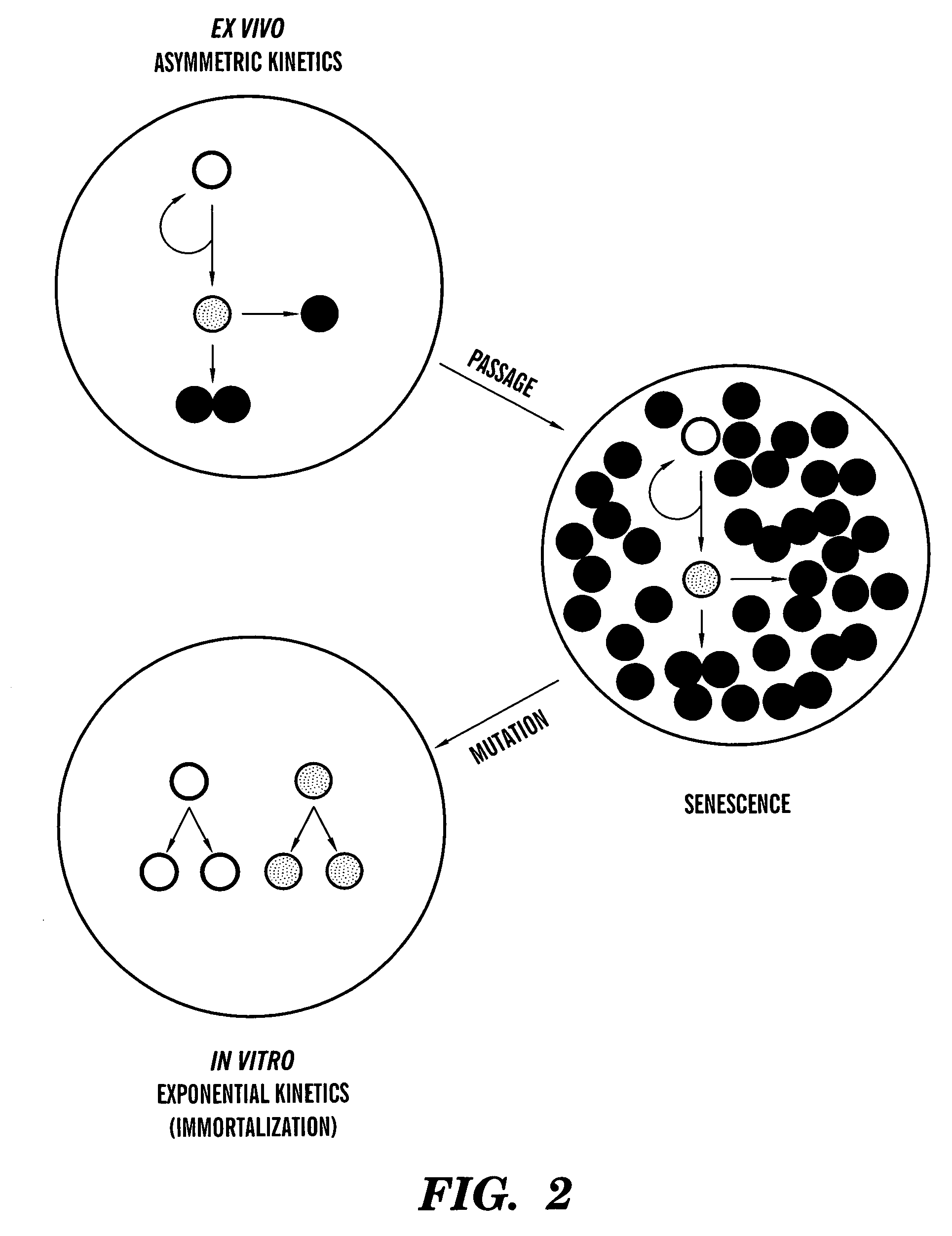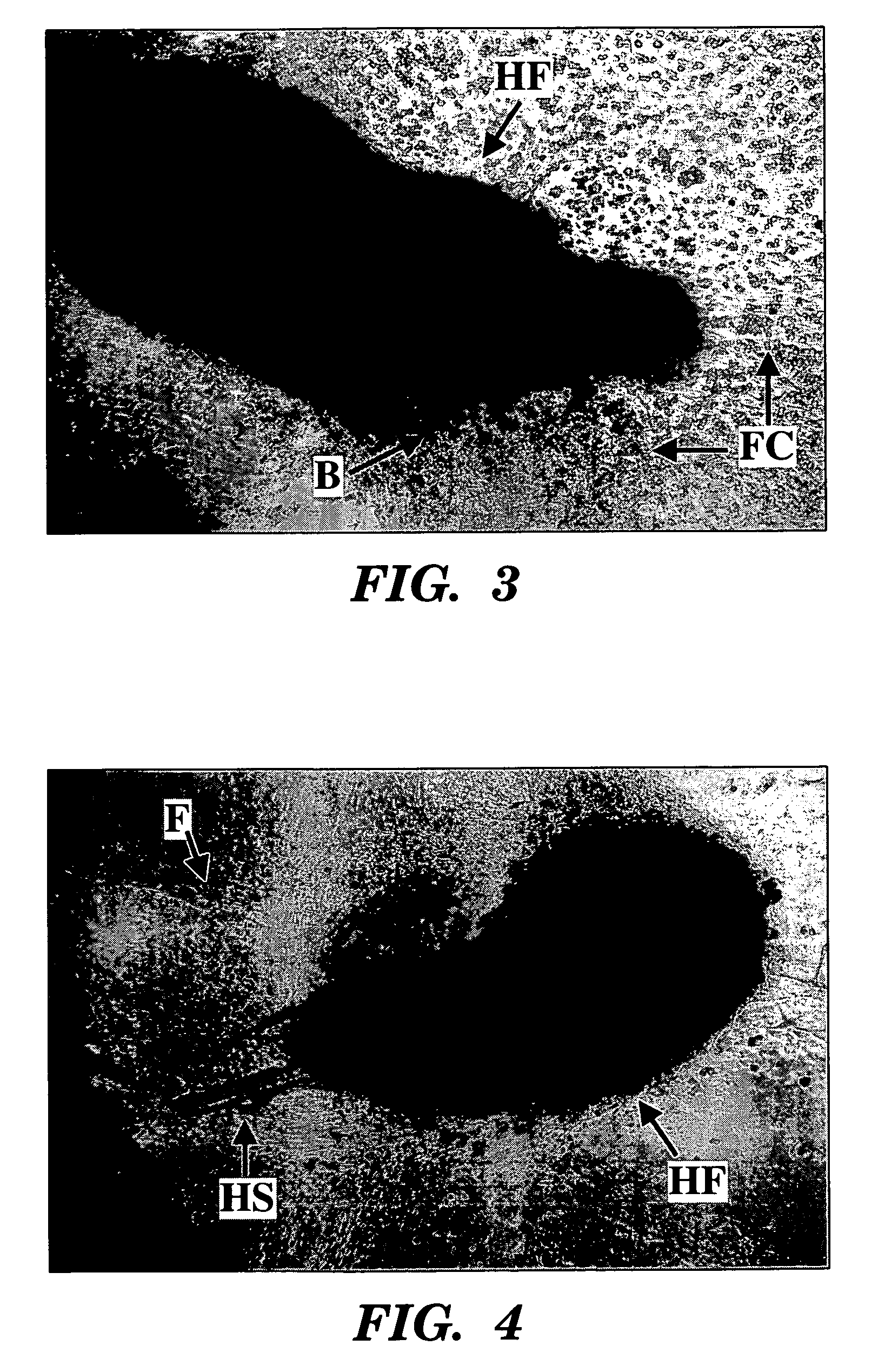Methods for ex vivo propagation of somatic hair follicle stem cells
a technology ex vivo expansion, which is applied in the field of ex vivo expansion of can solve the problems of difficult isolation and propagation of somatic stem cells, significant difficulty in obtaining human somatic hair follicle stem cells, and thermoregulation and dryness problems, etc., to achieve suppressed asymmetric cell kinetics, enhance guanine nucleotide biosynthesis, and limit dilution pla
- Summary
- Abstract
- Description
- Claims
- Application Information
AI Technical Summary
Benefits of technology
Problems solved by technology
Method used
Image
Examples
example 1
Propagation of Somatic Mouse Whisker Follicle Stem Cells
[0114]Purine nucleoside metabolites (i.e., rGNPrs) have been used as pharmacological agents to switch hair follicle stem cells from their default asymmetric cell kinetics program to symmetric kinetics. In mice, stem cells are thought to lie in the bulge region of the hair follicle. However, during the hair growth cycle, the cells are believed to migrate from the bulge region to a place at the base of the hair follicle known as the bulb (Fuchs, 2000). These migratory patterns and the general difficulty of dissecting these regions from hair follicles have foiled attempts to establish hair follicle stem cells lines. We have avoided these barriers by isolating intact mouse whisker hair follicles (methods of Kobayashi et al., 1993; Jahoda and Oliver, 1991), transecting them, and culturing outgrowth cells in the presence of three different agents, xanthosine (Xs), xanthine (Xn), and hypoxanthine (Hx). The purines Xn and Hx utilize di...
example 2
Transgenic Adult Stem Cell Producer Mice
[0123]We have generated transgenic mice ubiquitously expressing the xanthine phosphoribosyltransferase (XPRT) gene. We used the gene encoding for XPRT from the protozoan Leismania donovani. The XPRT enzyme can convert Xanthine into xanthosine monophosphate, the critical precursor for cellular guanine nucleotides. This enzyme has no mammalian counterpart and its substrate can enter the cell via ubiquitously expressed nucleobase transporters. Therefore, we can control the kinetics of adult stem cells expressing XPRT by supplementing with or depriving the culture medium of xanthine. In the presence of xanthine, XPRT-expressing cells increase their cellular level of guanine nucleotides independently of their normal endogenous pathway involving the conversion of inosine monophosphate to xanthosine monophosphate by the enzyme inosine monophosphate dehydrogenase.
[0124]We have generated transgenic mice ubiquitously expressing the XPRT gene under the c...
example 3
Use of a Colcemid Arrest Assay (CAA) to Provide Cell Kinetics Evidence for Derivation of Mouse Hair Follicle Stem Cells
The Colcemid Arrest Assay (CAA)
[0125]Asymmetric self-renewal is a defining property of adult stem cells. Depending on the extent of division in the non-stem cell lineage, the associated asymmetric cell kinetics can also be used to identify adult stem cells in culture. We have described the use of several assays for the detection of asymmetric cell kinetics in culture, including serial micro-colony analyses (Sherley et al., 1995ab; Lee et al., 2003), time lapse video microscopy (Rambhatla et al., 2001), and fluorescence in situ cytometry (Lee et al., 2003). We have also developed a new method for analysis of asymmetric cell kinetics in cultured cells that is based on flow cytometry detection of the production of non-cycling progeny cells. This development was motivated by our discovery that, even under differentiating conditions, adult hepatic stem cells continue to ...
PUM
| Property | Measurement | Unit |
|---|---|---|
| concentrations | aaaaa | aaaaa |
| pH | aaaaa | aaaaa |
| pH | aaaaa | aaaaa |
Abstract
Description
Claims
Application Information
 Login to View More
Login to View More - R&D
- Intellectual Property
- Life Sciences
- Materials
- Tech Scout
- Unparalleled Data Quality
- Higher Quality Content
- 60% Fewer Hallucinations
Browse by: Latest US Patents, China's latest patents, Technical Efficacy Thesaurus, Application Domain, Technology Topic, Popular Technical Reports.
© 2025 PatSnap. All rights reserved.Legal|Privacy policy|Modern Slavery Act Transparency Statement|Sitemap|About US| Contact US: help@patsnap.com



